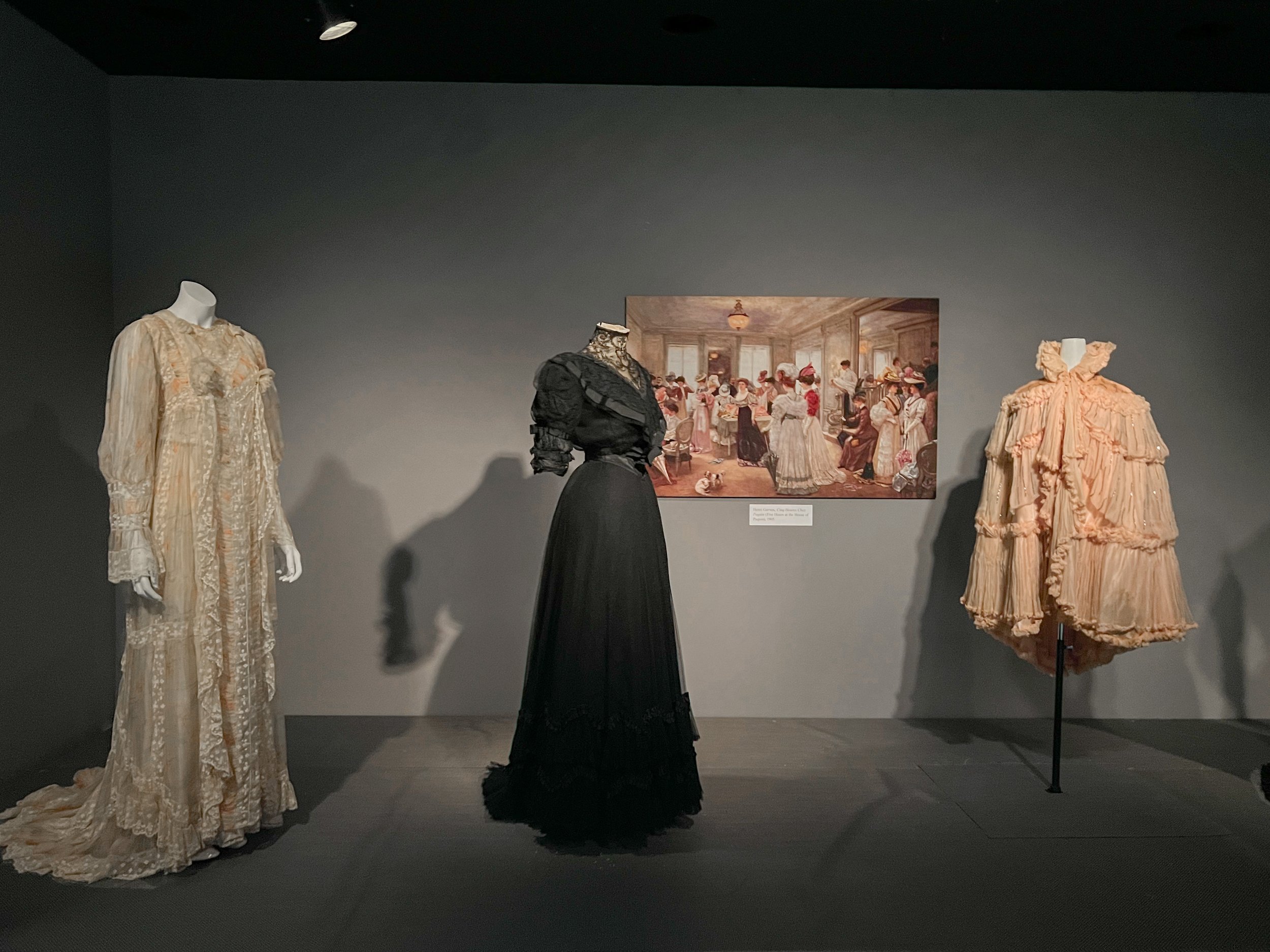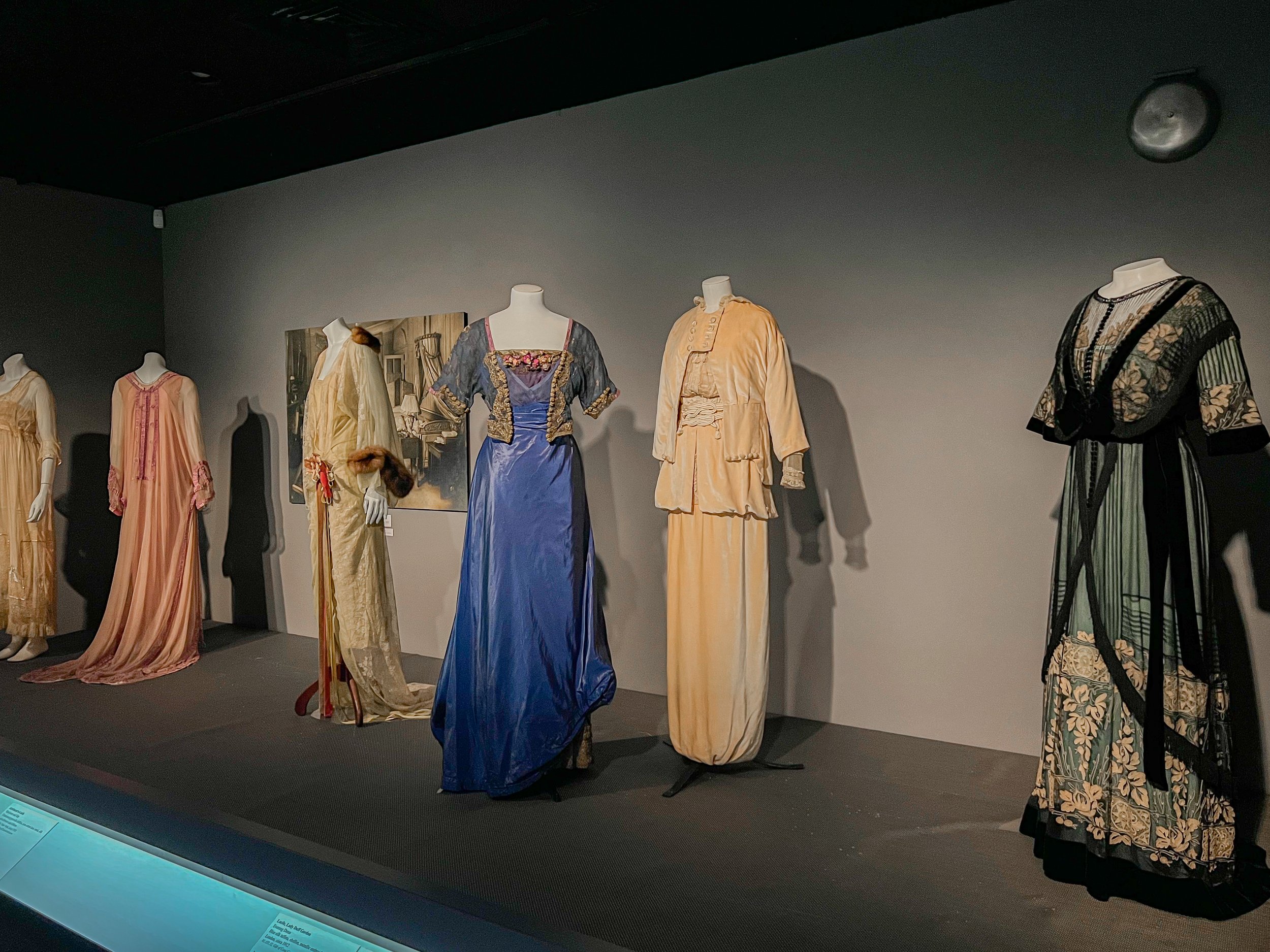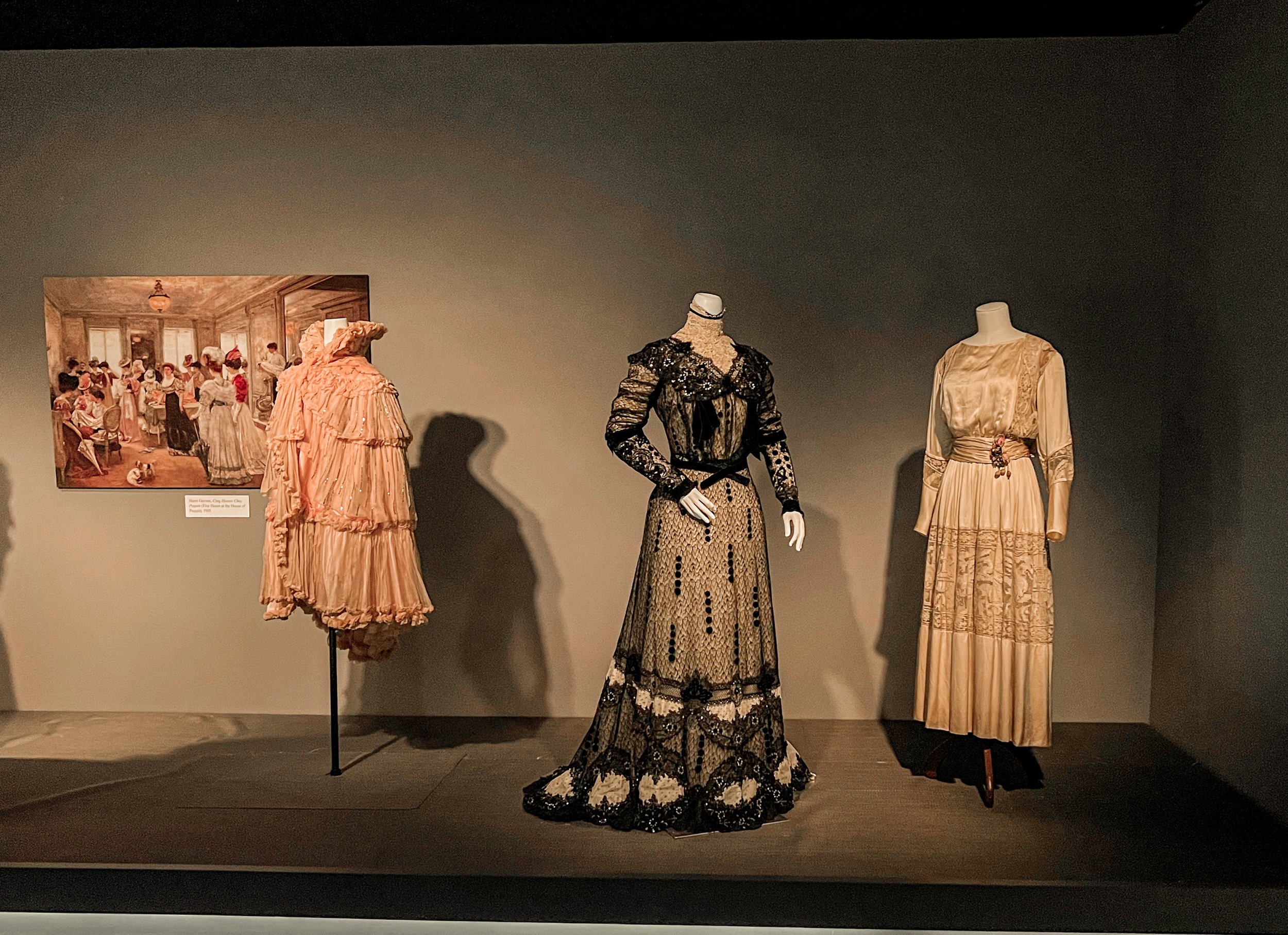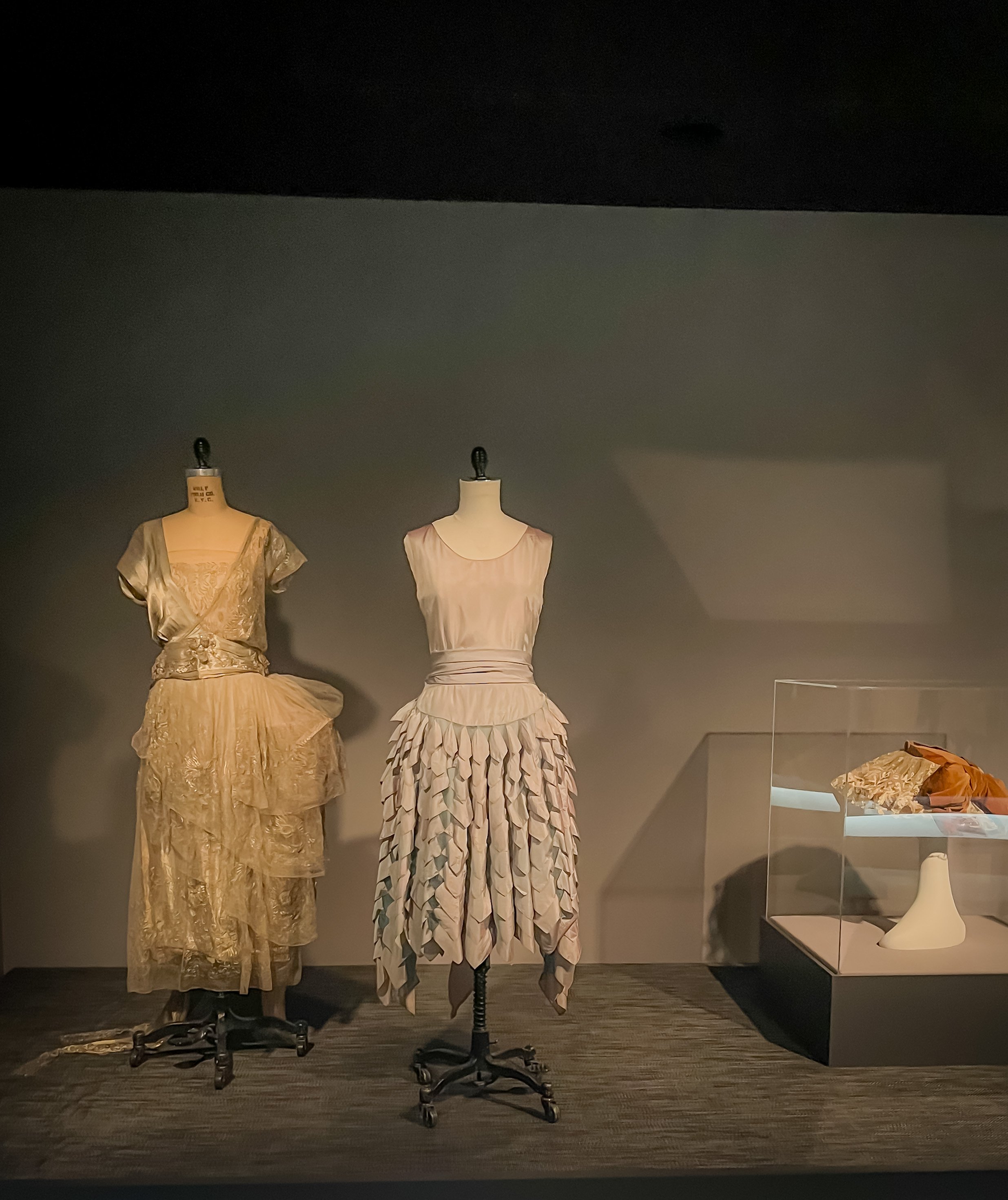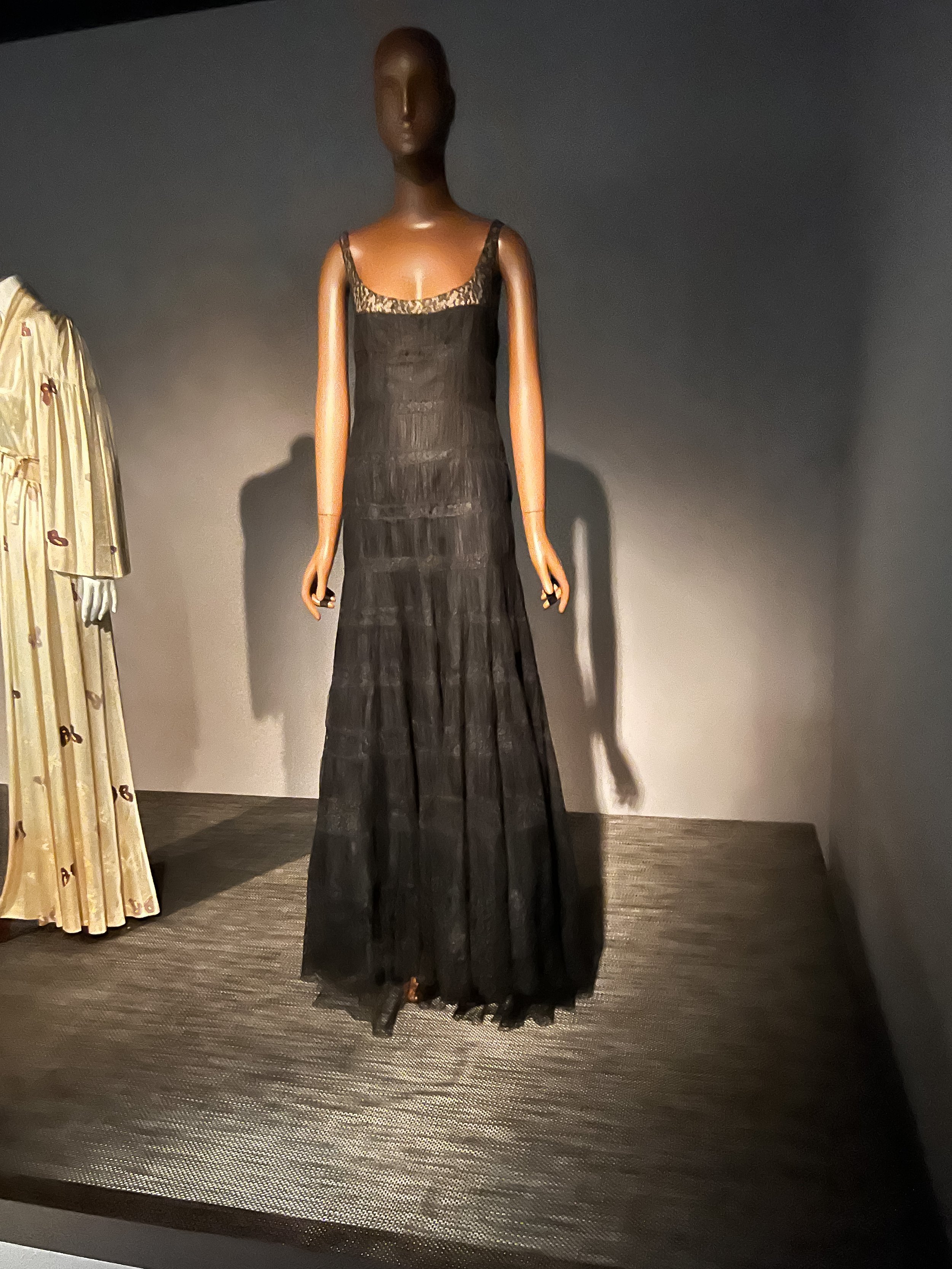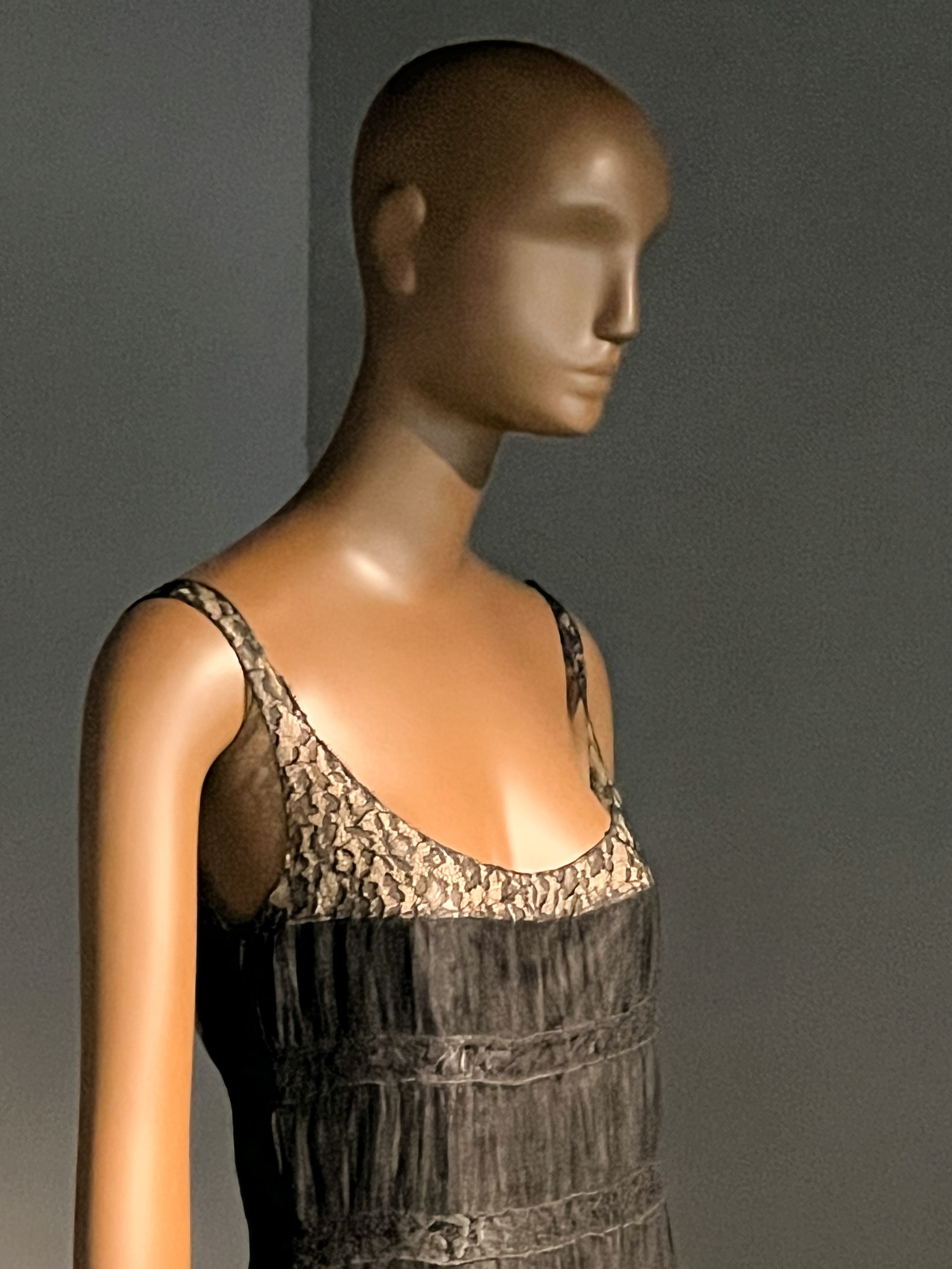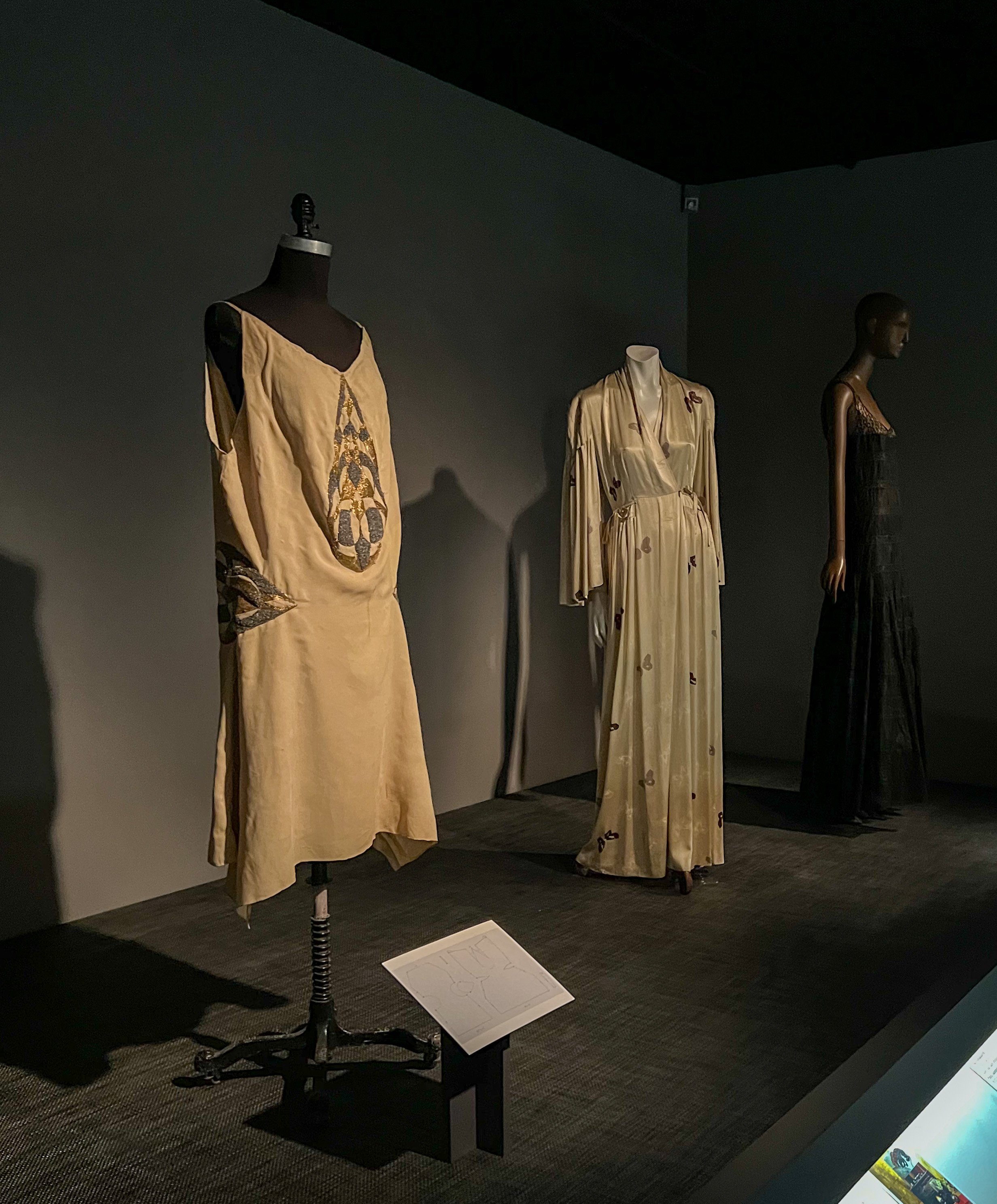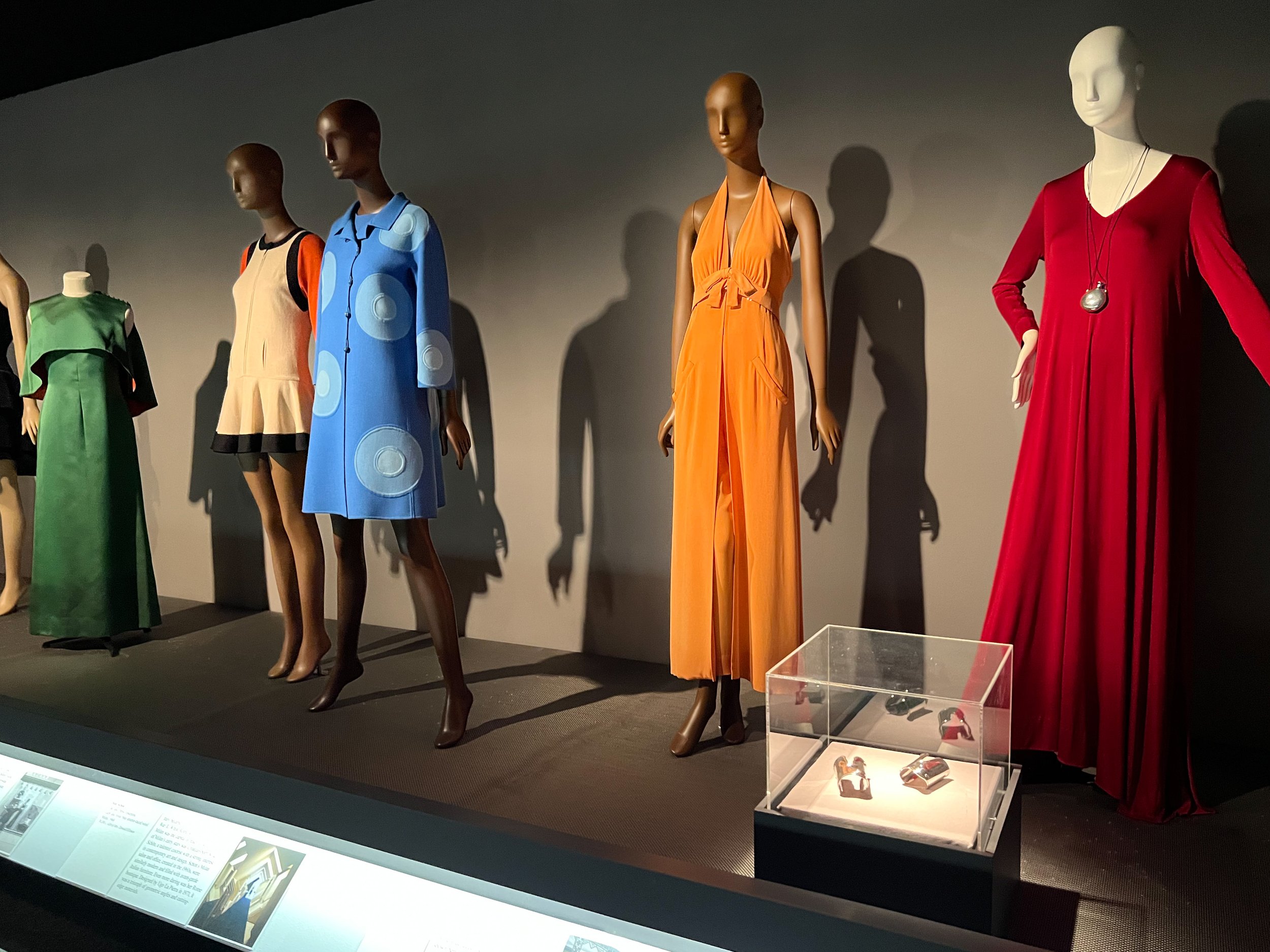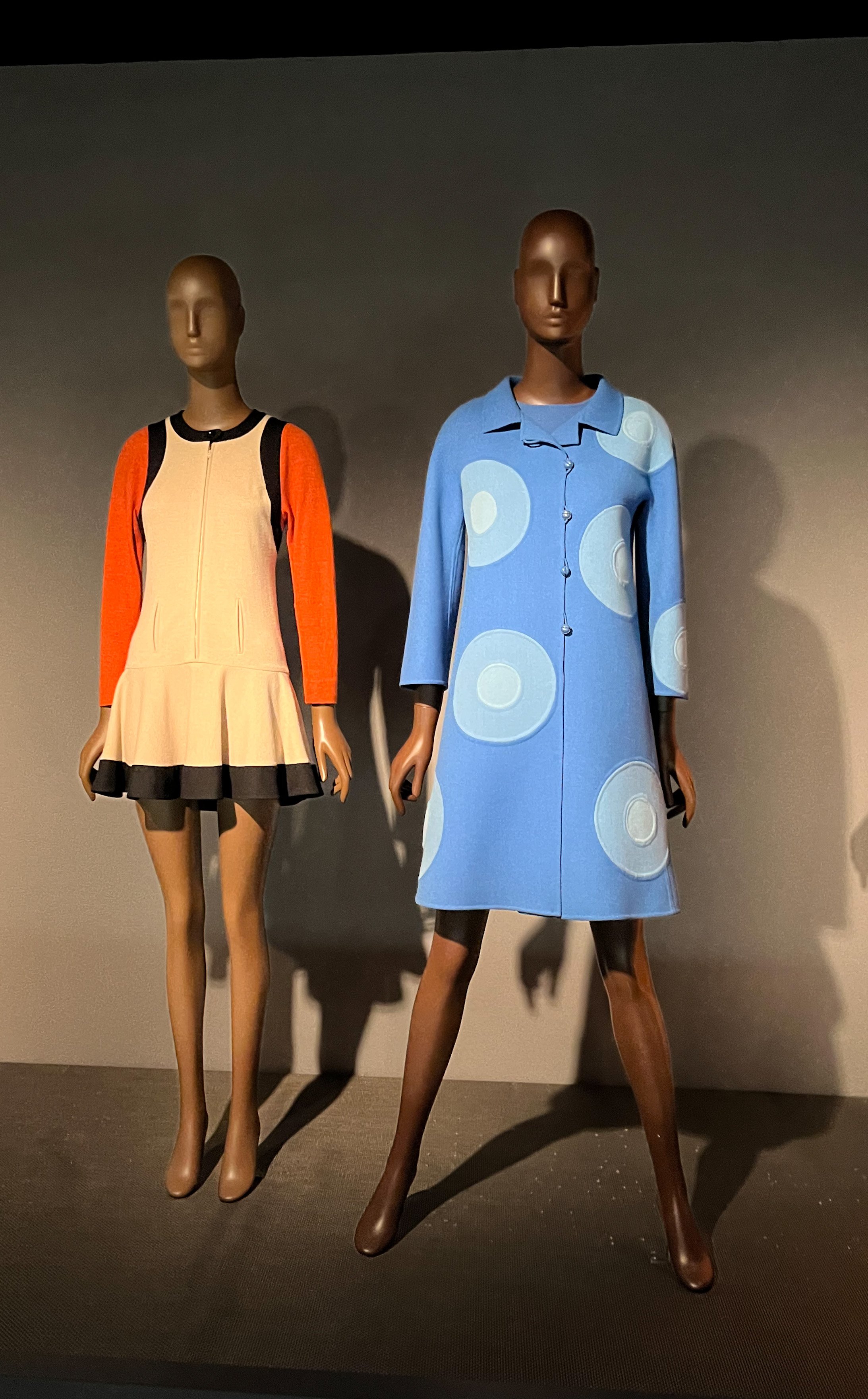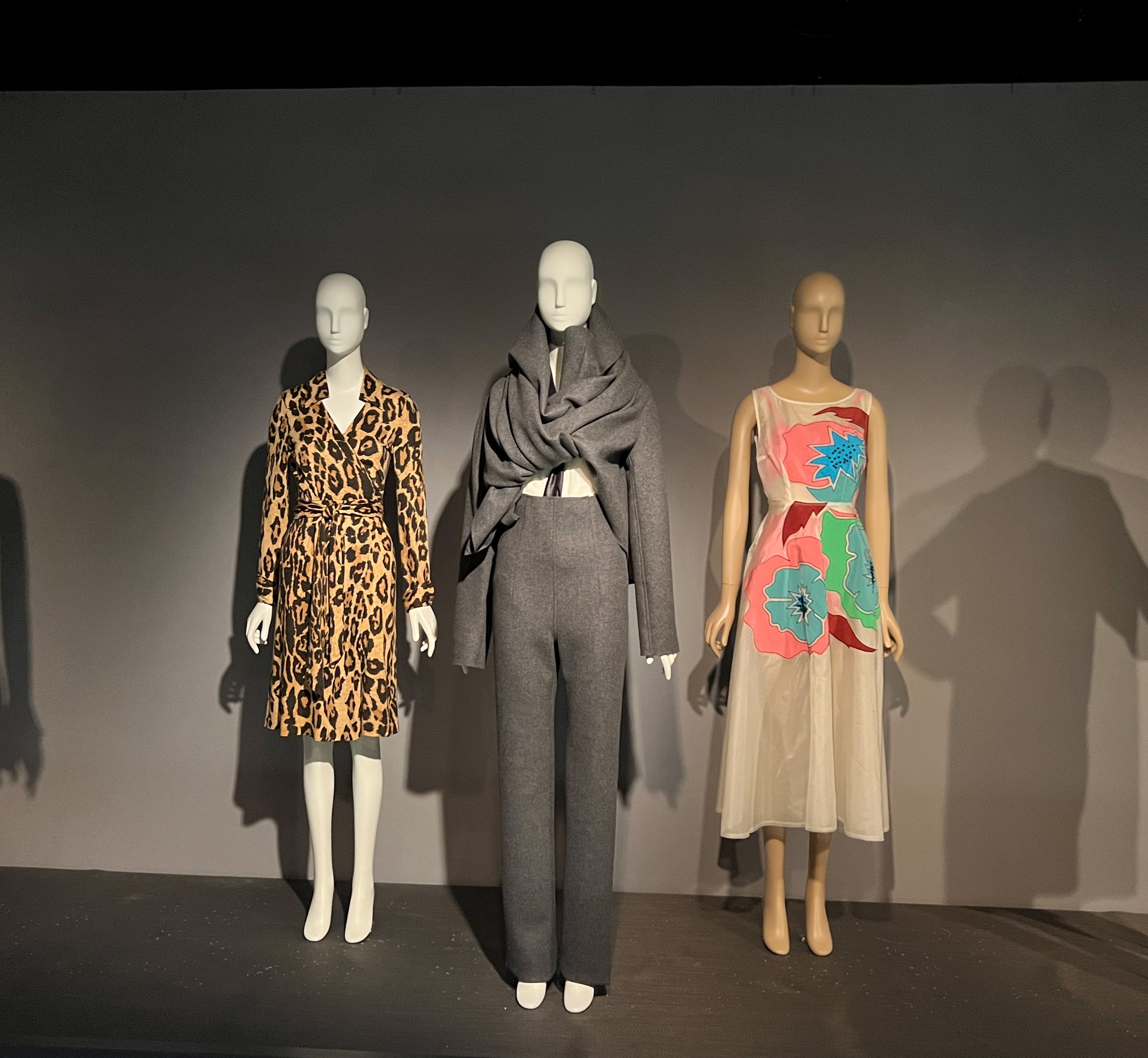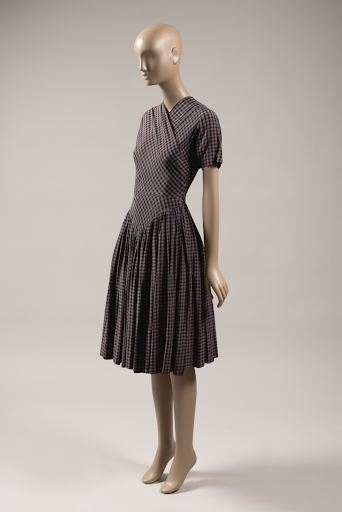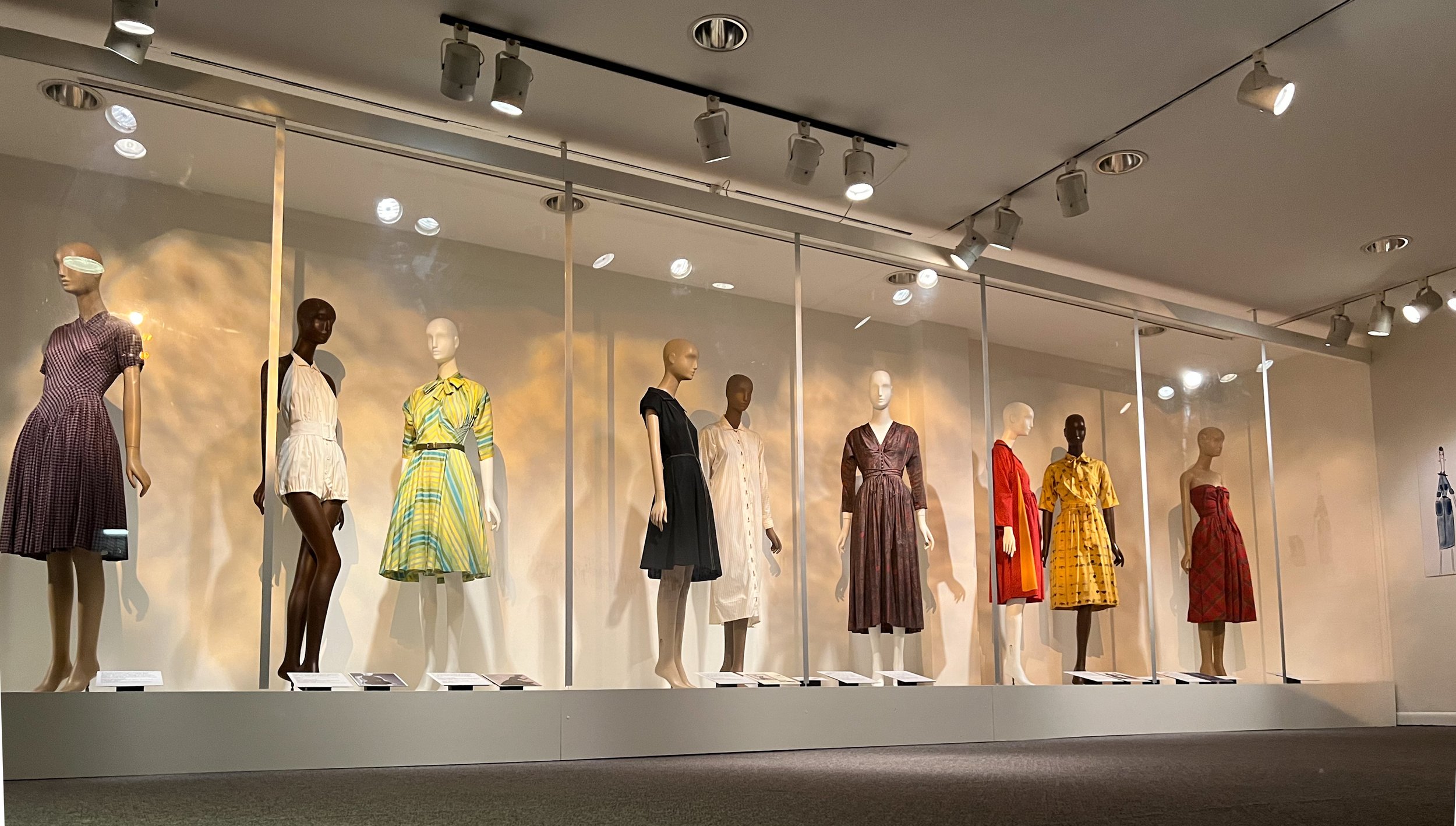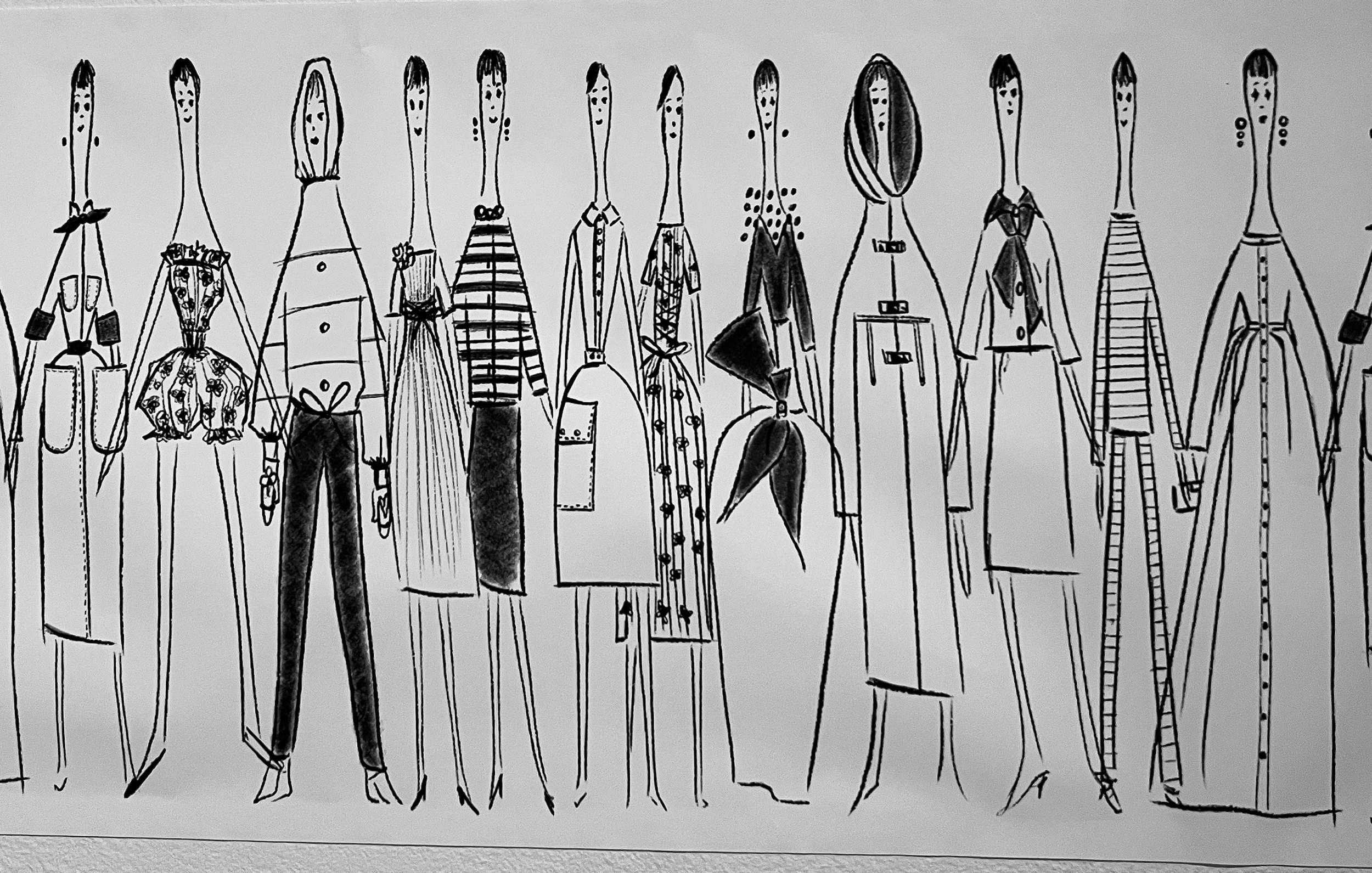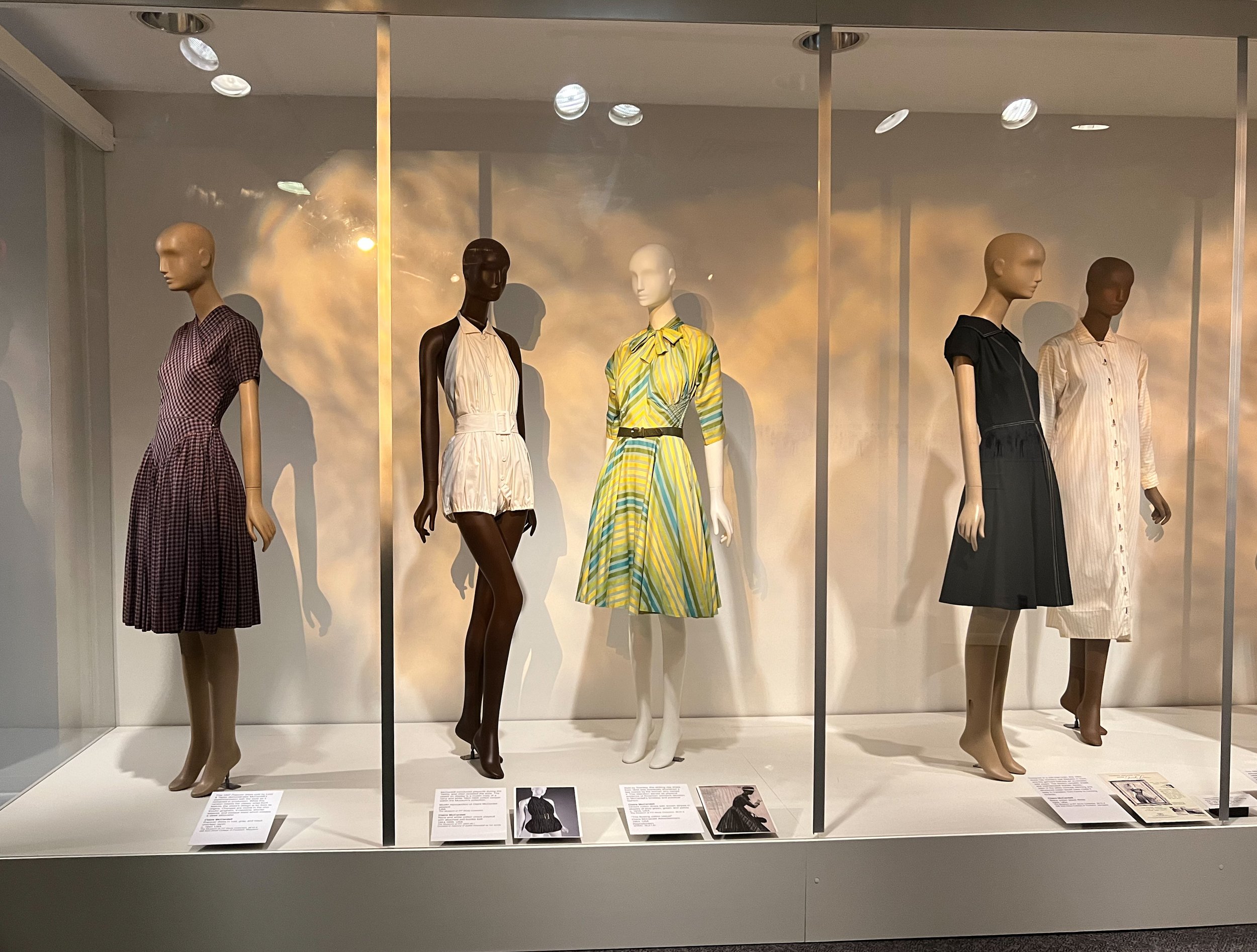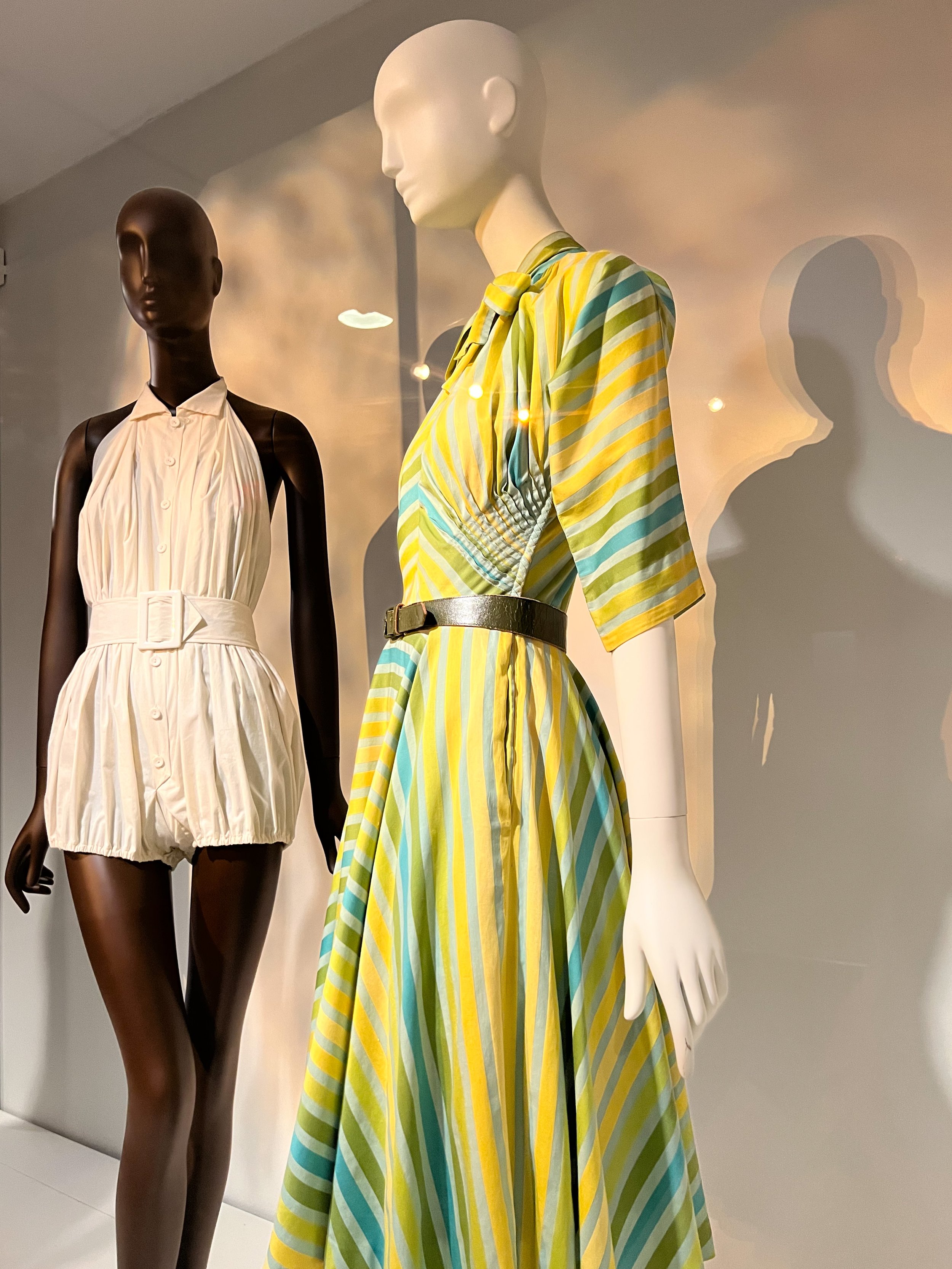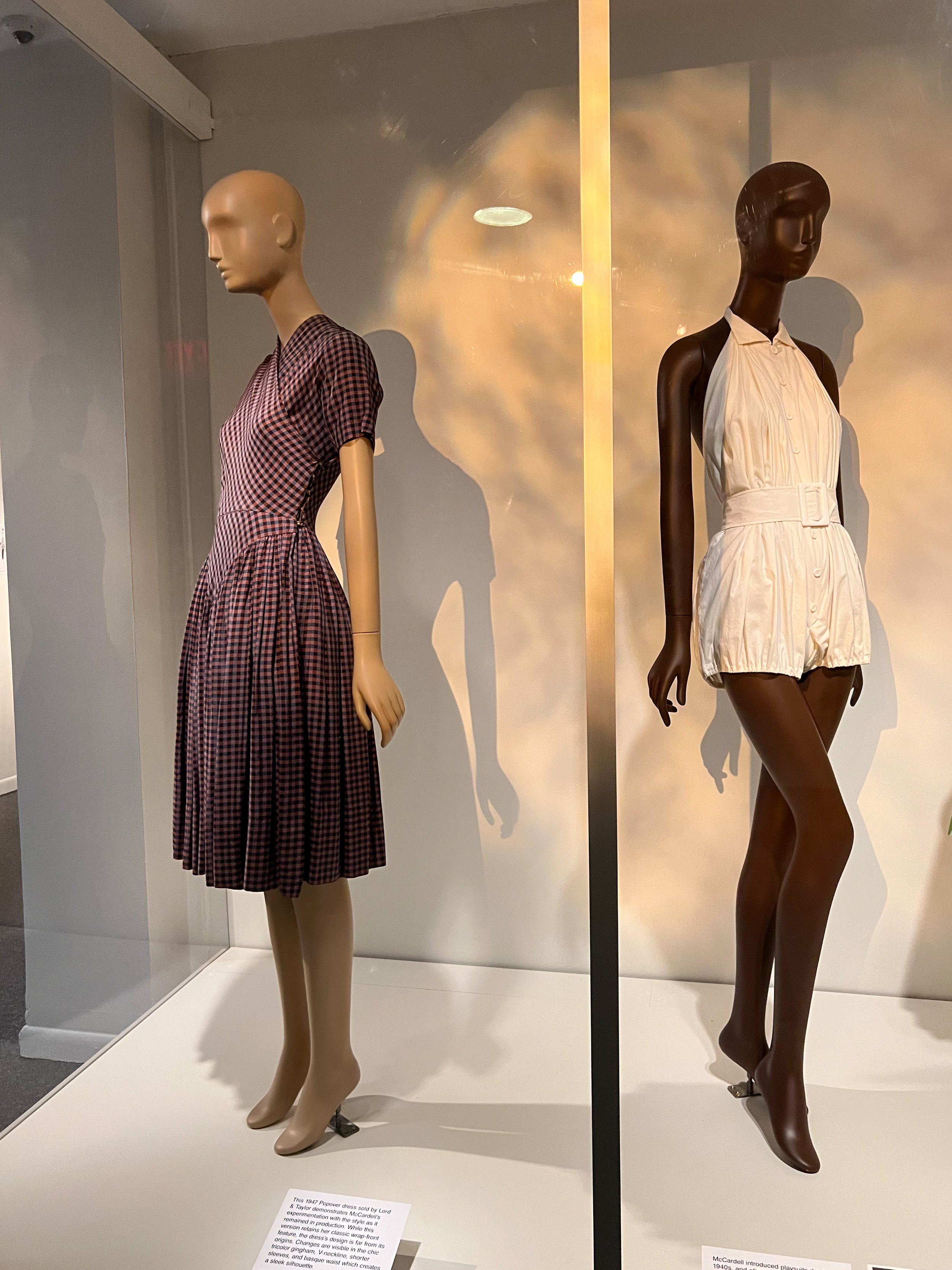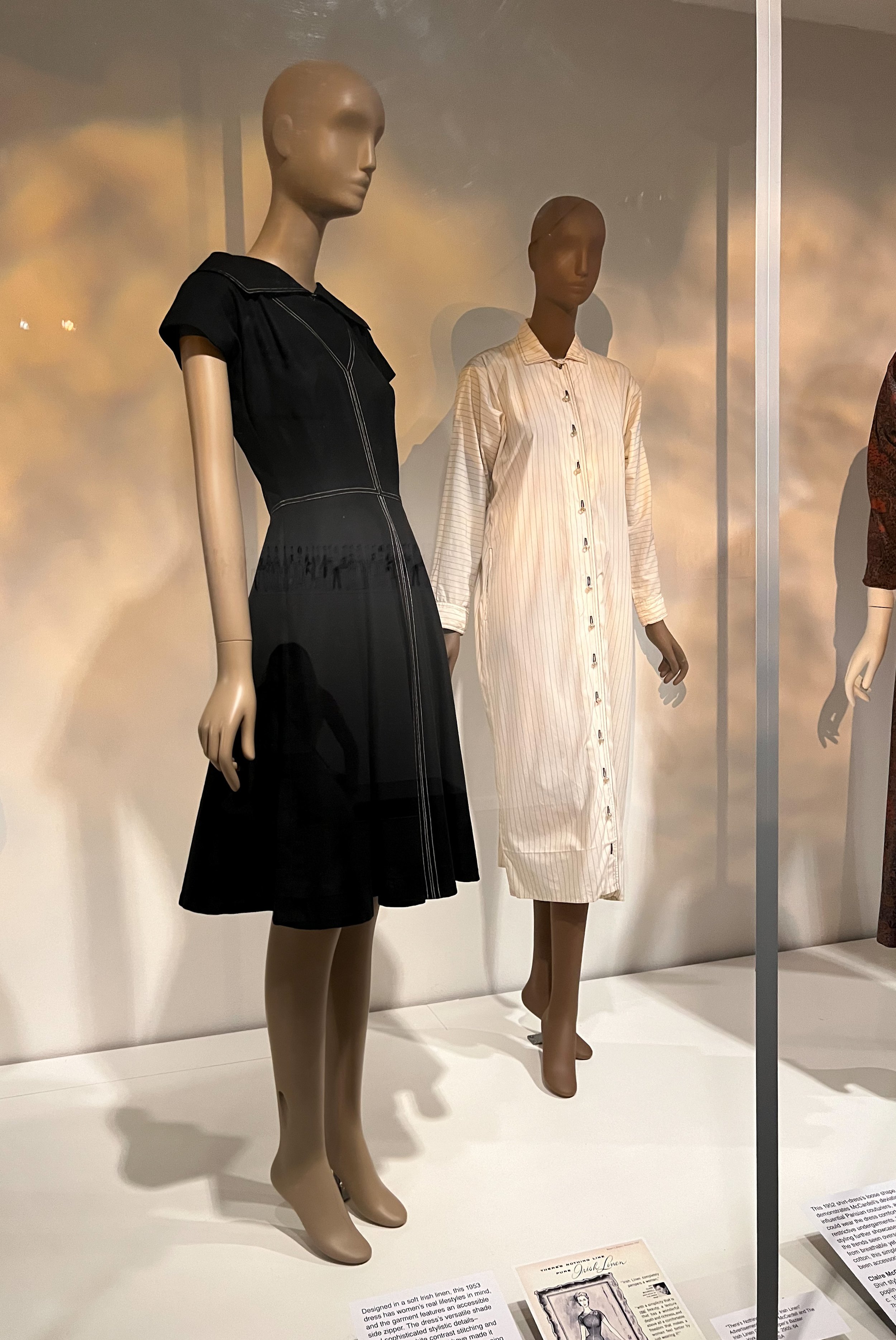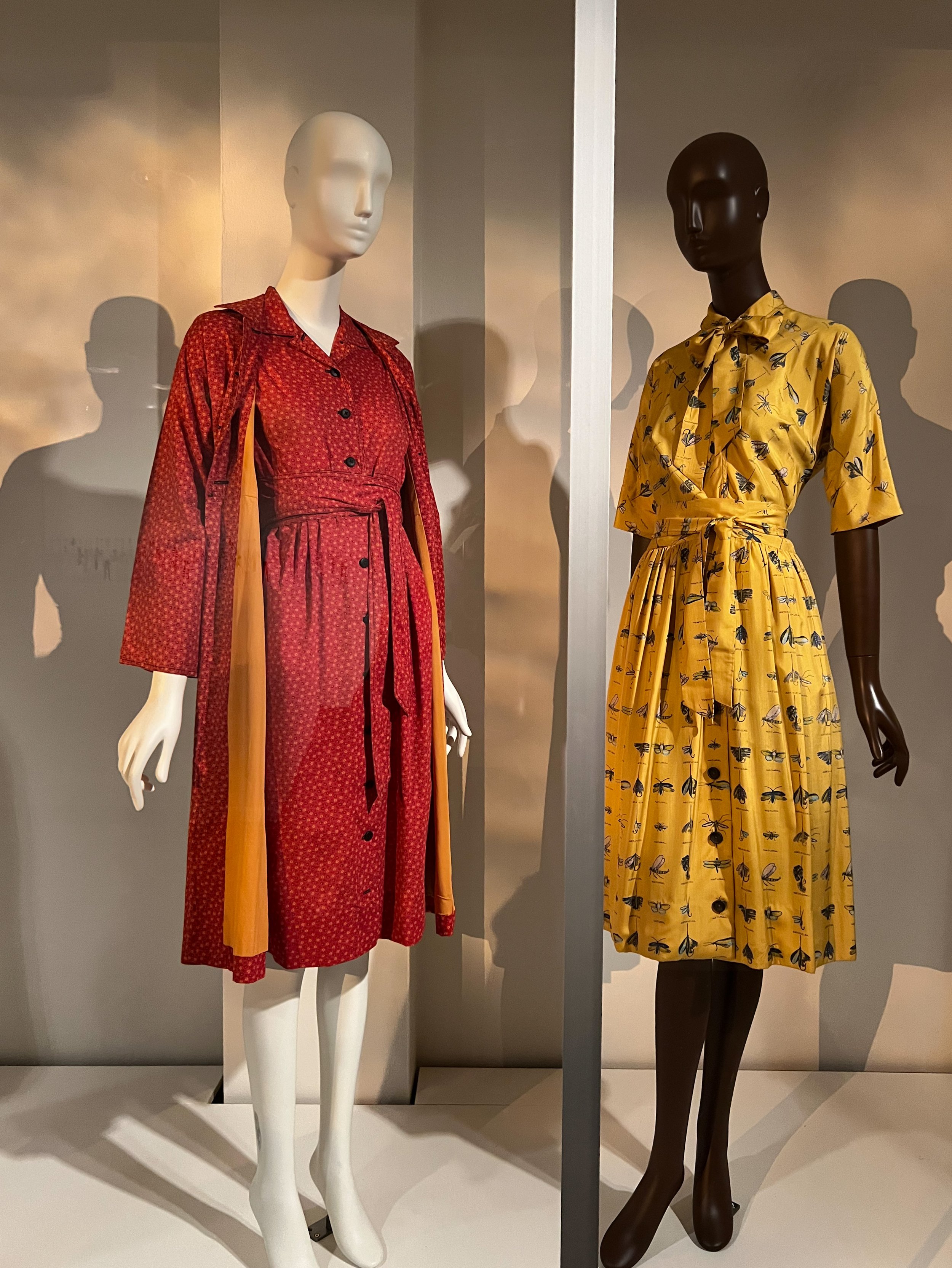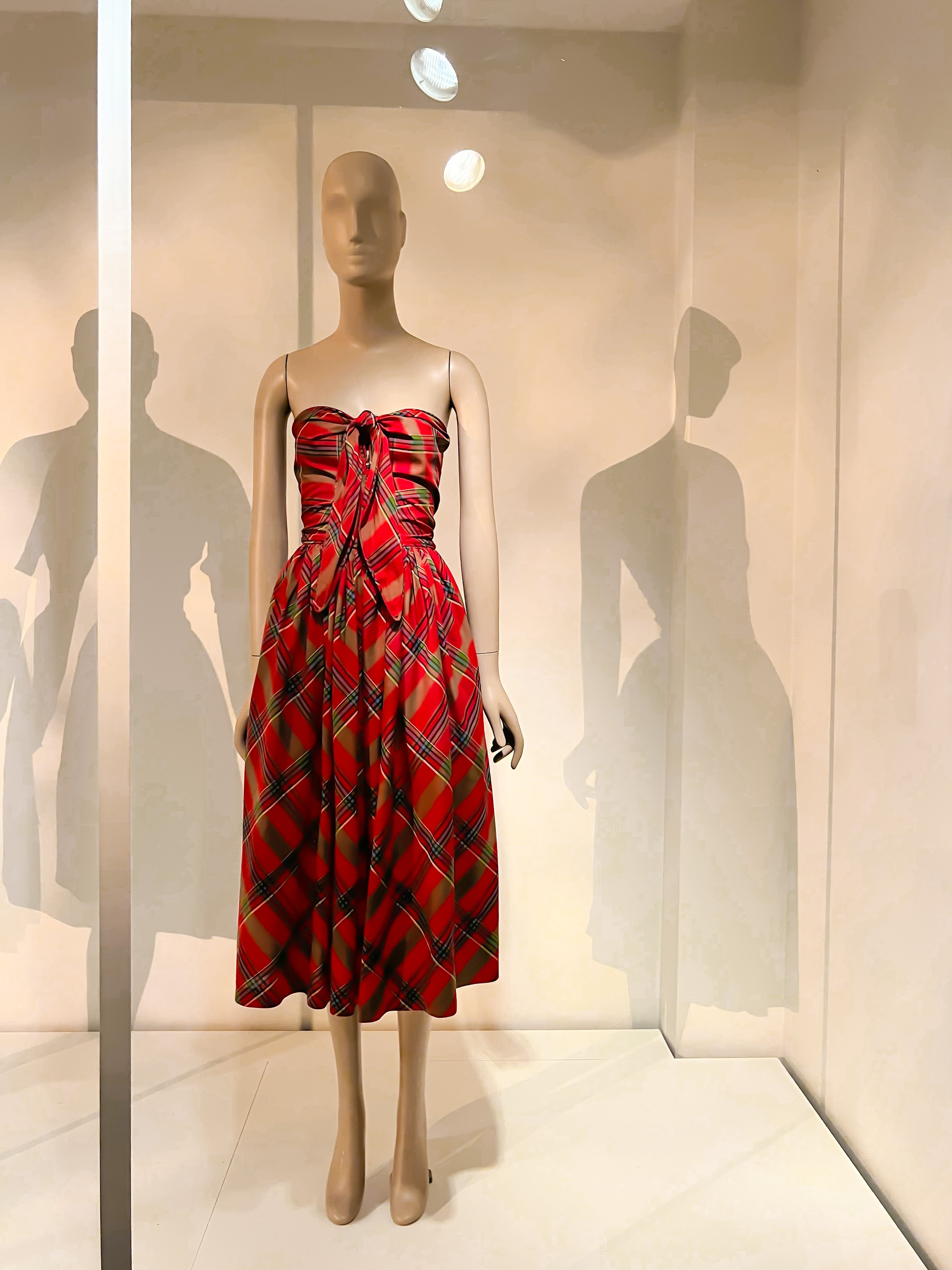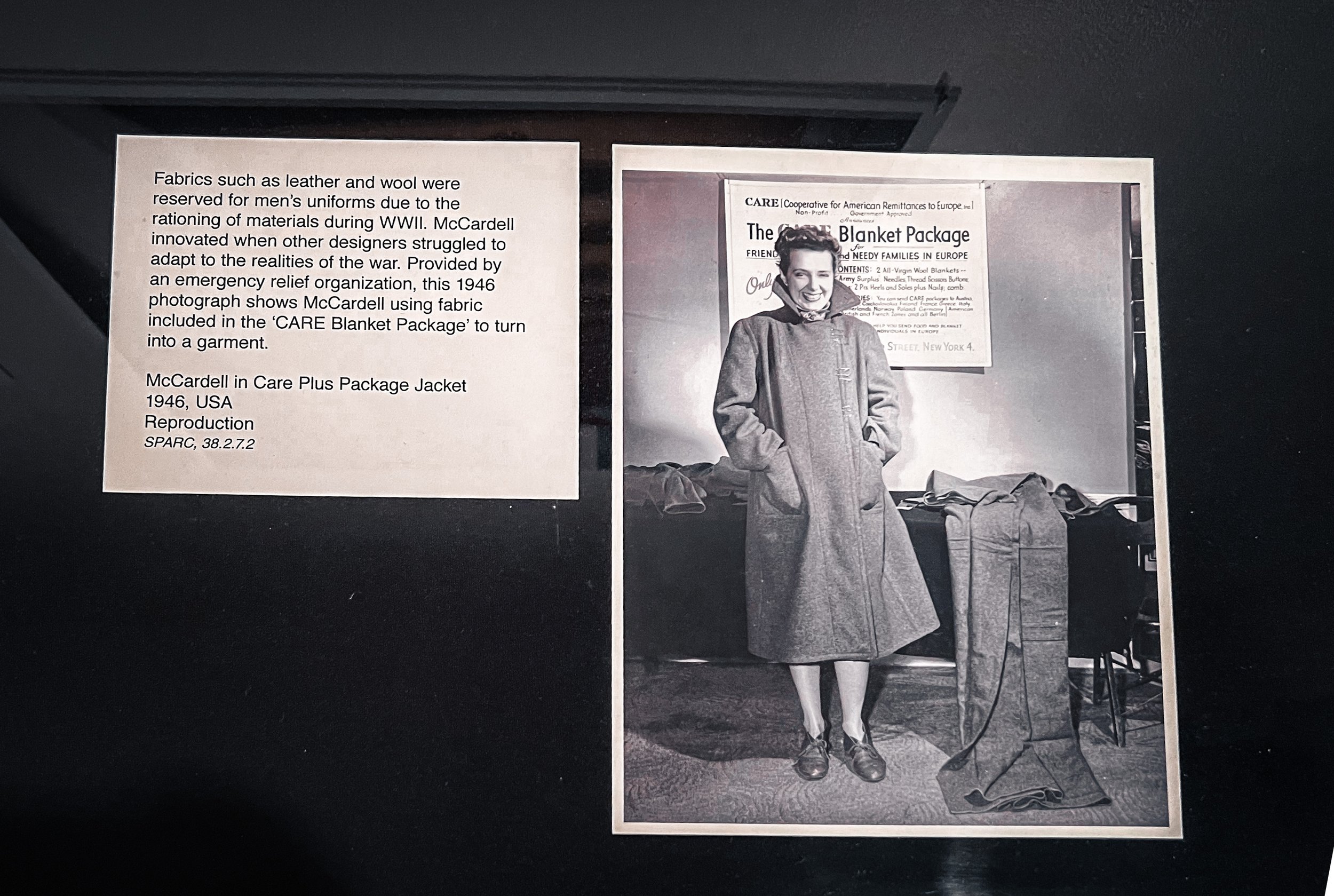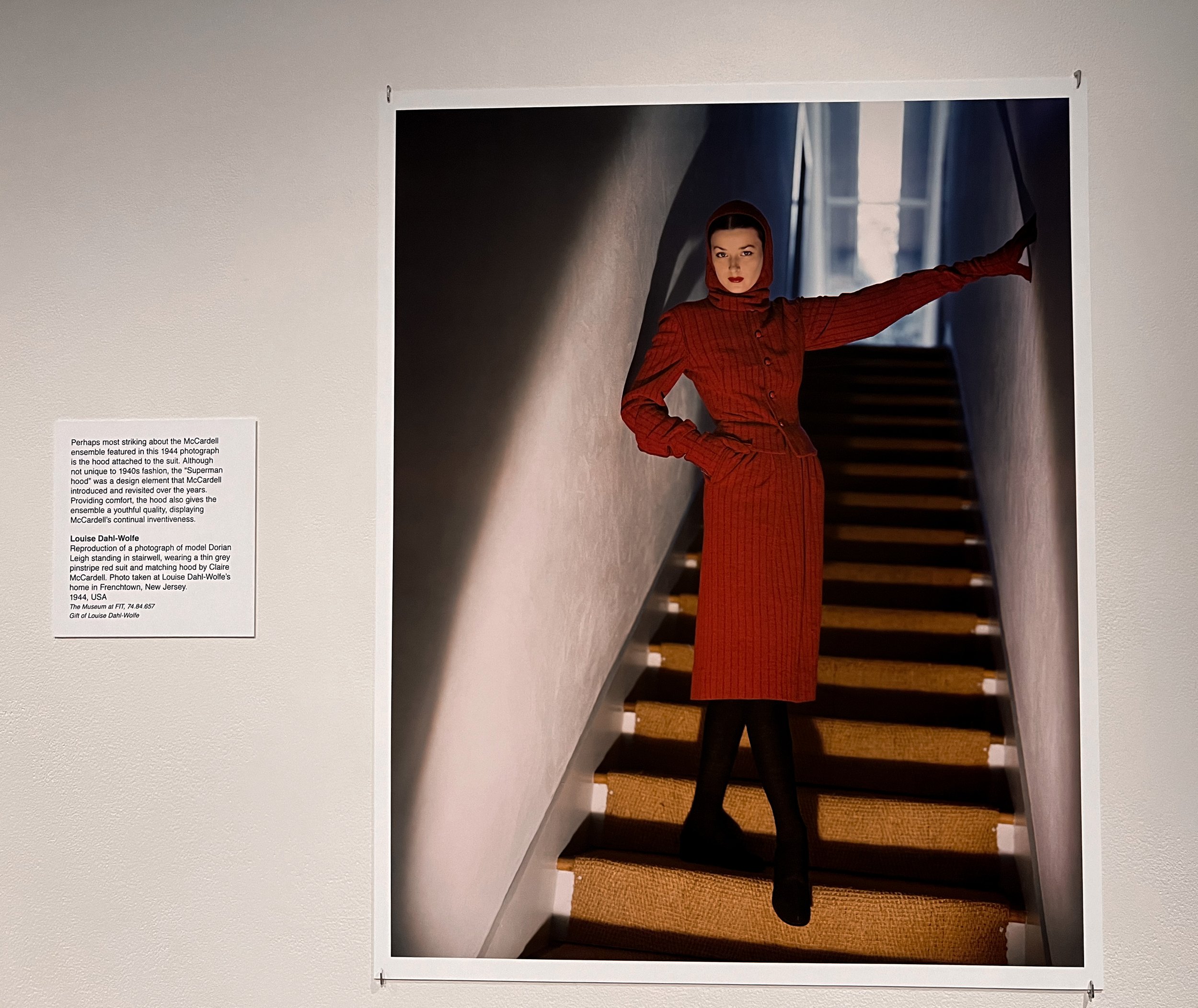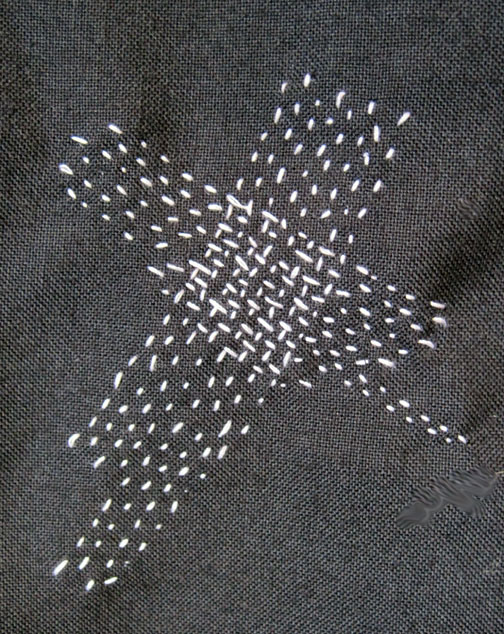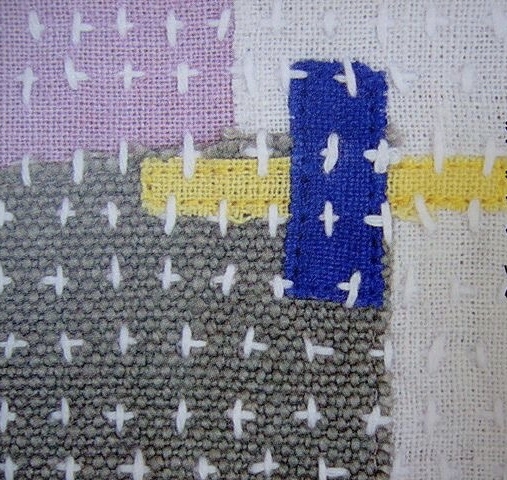Designing Women: Fashion Creators and Their Interiors
The recent exhibit at the Museum at FIT, Designing Women, Fashion Creators and their Interiors, beautifully captures the women behind the designs, her visions, her revolutions, her impact on the world and how her work influenced other women of their time– not in a prescriptive way, but rather by giving women new avenues for self-expression and empowerment. By pushing boundaries in both fashion and interior design, these designers expanded the realm of possibilities for women. By telling the story of the woman behind the designs, her visions, her revolutions, and her impact on the world – it shows how these women, through their work, transformed the spaces we live in and the clothes we wear.
Gowns attributed to Lucile, Lady Duff Gordon; at the Museum FIT exhibit: Designing Women: Fashion Creators and their Interiors
Designing Women: Fashion Creators and Their Interiors, a recent exhibit at the Museum at FIT, explores the interconnectedness of fashion and interior design through the lens of some of the most influential female designers of the 20th century. This exhibit was the second of five fashion exhibits that I saw while in NYC last month. Recently, I wrote about the student curated, Claire McCardell exhibit.
Fashion at its essence is a form of communication. Through it, we can express our identity, ideas, and aspirations. Since fashion reflects the cultural, political, and socio-economic context of a given period, this exhibit provides an opportunity to see how fashion influenced the creative process of some extraordinary twentieth-century fashion creators. While also inspiring a profound appreciation for the artistry and environmental influences that helped to shape their careers.
Gowns attributed to Lucile, Lady Duff Gordon and the Callot Sisters at the Museum FIT exhibit: Designing Women: Fashion Creators and their Interiors
Gowns by Jeanne Pauquin, at the Museum FIT exhibit: Designing Women: Fashion Creators and their Interiors
Understanding the Influence of 20th Century Women Designers
More than just a celebration of fashion, Designing Women, is an exploration of the creative process that reveals how fashion and design are used as a canvas to express views on femininity, comfort, luxury, and even rebellion. By challenging societal norms, the bold and pioneering clothing and interiors, redefined what fashion could be. Transforming not just the way women dressed, but also the way they lived.
You can see this duality in the work of Coco Chanel, for example. An icon of sophisticated simplicity, she prioritized comfort in her designs, while pioneering a new aesthetic of elegance that placed the modern woman at its core. Her Parisian apartment, with its neutral colors, exquisite minimalism, and mix of masculine and feminine elements, echoed the same philosophy. It portrayed luxury in the realm of comfort, serving as a physical extension of her avant-garde vision for women's fashion.
Coco Chanel, and Elsa Schaiparelli (right) at the Museum FIT exhibit: Designing Women: Fashion Creators and their Interiors
Detail Chanel Black Lace Evening Dress, C. 1932
Madeleine Vionnet, Schaiparelli, and Chanel dresses,
Chanel’s work was juxtaposed with designers such as Madeleine Vionnet, Jeanne Paquin, Elizabeth Hawes, Bonnie Cashin, Anna Sui, and Elsa Schiaparelli. Schiaparelli’s home, with its whimsical and provocative elements, was such a reflection of her Surrealist leanings. Underscoring how each woman's living space and their sartorial creations are truly an extension of their fashion ethos.
Placed within the broader historical context of the twentieth century, the curator, Deputy Director, Patricia Mears has skillfully incorporated the prevailing social, cultural, and artistic movements of the time, enabling visitors to better understand the designers' motivations, inspirations, and the impact their work had on society. This historical framework serves as a valuable backdrop, enhancing our appreciation for the transformative power of design and how it shaped the spaces we live in and the clothes we wear today.
As I meandered through the gallery, I could more fully appreciate how the personal philosophies of the designers became intrinsically woven into their work, and how their interiors were both a reflection and an extension of their personal styles. Not as separate spheres of private and public, fashion and interiors, but as a single canvas of personal expression for their revolutionary ideas. With each vignette, I looked for parallels and differences, for echoes and deviations. Remembering that each of these women was not only creating beautiful clothing, but also a new paradigm for women in their time.
Exploring Fashion and Interior Design
I often encourage my fashion students to go to museums and to look beyond the visual aesthetics and to think about the cultural, social, and historical context. To engage with the exhibition not just as an observer, but as a student of history and culture. Above all, I ask them to remember, every designer leaves a bit of herself in her work. Our job is to find and understand it.
Pauline Trigère, Mary Quant, Mila Schoën, Irene Galitzine, and Halston with Elsa Peretti “Bone” cuffs and “Bottle Open Bottle” Necklace.
Mary Quant and Mila Schön
Bonnie Cashin ensembles.
Gowns by Anouska Hemple and Carolyne Roehm.
Bonnie Cashin, Barbara Hulanicki for Biba, Diane von Furstenberg, Yeohlee, Tracy Reese, Anna Sui.
Diane von Furstenberg, Yeohlee, and Tracy Reese.
How Designing Women Transformed Fashion and Interior Design
Drawn from the Museum at FIT’s permanent collection, this exhibit beautifully captures the women behind the designs, her visions, her revolutions, her impact on the world and how her work influenced other women of their time– not in a prescriptive way, but rather by giving women new avenues for self-expression and empowerment. By pushing boundaries in both fashion and interior design, these designers expanded the realm of possibilities for women. By telling the story of the woman behind the designs, her visions, her revolutions, and her impact on the world – it shows how these women, through their work, transformed the spaces we live in and the clothes we wear.
I left with a renewed understanding of the transformative power of fashion, the significance of personal spaces, and the enduring legacies of these influential women. Designing Women is not only a celebration of their accomplishments but also a testament to the ongoing dialogue between fashion, art, and the spaces in which creativity flourishes. By highlighting these intertwined narratives, the exhibit encourages viewers to think more deeply about the cultural and historical contexts that these designers navigated, thus providing a comprehensive understanding of their contributions.
/\/\/\/\/\/\/\/\/\/\/\/
Hilarie
Designing Women: Fashion Creators and Their Interiors
At the Museum at FIT, November 30, 2022- May 14, 2023
Claire McCardell Exhibition at FIT: Exploring Fashion's Pioneer
In the world of fashion, certain designers leave an indelible mark on the industry, shaping trends and redefining the way we dress. One such visionary is Claire McCardell, whose groundbreaking designs continue to inspire and captivate fashion enthusiasts even today. In April, I was able to see a captivating exhibition celebrating the remarkable legacy of Claire McCardell, at the Museum at the Fashion Institute of Technology (FIT): Claire McCardell, Practicality Liberation, Innovation. This small exhibit showcased some of her revolutionary designs while highlighting her enduring influence on contemporary fashion.
Claire McCardell
Practicality, Liberation, Innovation
Claire McCardell, Popover dress, rayon, brass hooks & eyes, c. 1947, Lord & Taylor, American, founded 1826, Gift from Hood College of Frederick, Maryland, 96.61.6
In the world of fashion, certain designers leave an indelible mark on the industry, shaping trends and redefining the way we dress. One such visionary is Claire McCardell, whose groundbreaking designs continue to inspire and captivate fashion enthusiasts even today. In April, I was able to see a captivating exhibition celebrating the remarkable legacy of Claire McCardell, at the Museum at the Fashion Institute of Technology (FIT): Claire McCardell, Practicality Liberation, Innovation. This small exhibit showcased some of her revolutionary designs while highlighting her enduring influence on contemporary fashion.
As a lifelong McCardell fan, the is the second exhibit of her work that I have seen in six months. Before then, it had been about 30 years. Needless to say, I was thrilled.
A Pioneer in American Fashion:
Claire McCardell, born in 1905, emerged as a pivotal figure in American fashion during the mid-20th century. Known for her avant-garde approach to design, McCardell challenged conventional norms by prioritizing comfort, practicality, and freedom of movement in her garments. She played a significant role in shaping the modern concept of American sportswear, which emphasized simplicity, functionality, and wearability.
The exhibition was organized by four college seniors in the undergraduate program in Art History and Museum Professions (AHMP Program) at FIT. The garments showcased, are culled from the FIT Study Collection, with additional historical records from the Gladys Marcus Library’s Special Collection & College Archives.
Organized into three sections, Practicality Liberation and Innovation, this exhibit offers visitors a unique opportunity to witness the evolution of McCardell’s career and gain insights into her creative process. The curation captures McCardell's distinctive style, highlighting her groundbreaking use of fabric, innovative garment construction techniques, and keen eye for detail.
McCardell's designs were characterized by their clean lines, unstructured silhouettes, and inventive use of fabrics such as denim, menswear suiting woolens, and cotton. She introduced several innovative design elements that are now considered industry standards. For instance, the use of unique closures, such as grommets and hooks and eyes, spaghetti string ties and well-proportioned pockets are all McCardell-isms. The ballet flat as a shoe style, now a staple in every woman's wardrobe, can be traced back to McCardell's ingenious creations. She also popularized the concept of mix-and-match separates, allowing women to effortlessly combine different pieces to create versatile outfits.
Challenging Norms and Promoting Individuality: McCardell's designs not only prioritized comfort and practicality but also challenged societal norms, encouraging individuality and self-expression. She designed clothing that catered to the changing needs of women, both in domestic and public spheres, and even adhered to war rationing guidelines. By liberating women from cumbersome and restrictive clothing, McCardell truly transformed the fashion landscape. Her emphasis on functionality and ease of wear continues to resonate with modern designers, ensuring her lasting influence.
Below is a gallery of images of the garments.
Beyond showcasing McCardell's designs, the exhibition walls and tables were lined with reproductions of photographs as well as advertisements, flyers, newspaper clippings and letters to place the social and cultural context in which her work emerged. Visitors were encouraged to contemplate the impact of World War II on fashion and witness how McCardell's designs responded to the era's challenges, embracing a sense of optimism and liberation.
Claire McCardell's trailblazing designs serve as a source of inspiration for students, designers and enthusiasts alike. Her ability to bridge the gap between high fashion and practicality continues to influence contemporary fashion, encouraging the exploration of innovative techniques and the creation of garments that empower individuals to express their unique style.
The Claire McCardell exhibition at the Museum at FIT is a testament to the enduring legacy of this remarkable designer. Her contributions to American fashion, her innovative design philosophy, and her unwavering commitment to creating comfortable yet stylish clothing continue to inspire and captivate fashion enthusiasts and designers alike. Exploring the exhibition provides a glimpse into McCardell's revolutionary designs and the profound impact she had on shaping the fashion industry. Claire McCardell's remarkable vision serves as a reminder that fashion can transcend trends and that timeless design can continue to shape and influence the way we dress for generations to come.
/\/\/\/\/\/\/\/\/\/\/\/
Hilarie
To see more photos, follow the hashtag on social media. #clairemccardellMFIT
Introducing: Sew your own Wraps, Capes & Cover-ups. A Garment Sewing Primer.
I wrote this book to get you excited about making clothing that you will love wearing. The projects are all loose fitting so that you can concentrate on sewing and design and not get too focused on fitting. I show you how to manipulate fabric to make a wardrobe of timeless fashion accessories. Though it is really in the fabrication and finish of each garment where the true test of quality lies. The finish is exceptionally important. Clothing should be as beautiful on the inside as it is on the outside. The sewing techniques and projects in this book emphasize this principle of quality construction. Beyond the projects, the book is about craftsmanship. It explains in text and photos how to finish seams, embellish garments, and some pattern manipulation techniques that I hope will inspire you to expand your sewing skills.
It is hard for me to believe that I’ve nearly finished my second book, Sew Your Own Wraps, Capes & Cover-ups. As I work on the last of the illustrations, I am left feeling both exhausted and invigorated. Writing a book feels a whole lot like having a baby. From proposal to publication It takes about a year and a half of nearly everything you’ve got. Then it is submitted to the publishing team to take over and suddenly- is no longer “yours”.
The editing process is tough-and it can feel so personal. The manuscript and patterns get passed along to a variety of editors to comb through, question, mark up and pass back. Of course, without their skillful consideration- there would be no book! Since this was my second time writing a book, I thought- “I’ve got this! “– and was convinced that it was going to so much easier than the first one. Then 2020 began.
The manuscript and projects were due at the end of March- only a few weeks after the Governor of Virginia issued Stay at Home orders. At first the initial 2 -week shelter in place, seemed like a dream. More time to write and think! But, my kids were home too and those early days were filled with so much anxiety. Over time, we began to feel our way through it, and find a quiet, slower pace. The book provided a much-needed distraction. A distraction from politics, from Covid-19, from anxiety, from life really.
From March- July my business was closed. I was afraid. Besides not bringing in any income, I was issuing refunds each week as more classes, workshops, parties and camps were cancelled. Fortunately, I was able to rearrange my workspace and come up with a plan to return to teaching the day the restrictions were lifted and Virginia went into Phase 3.
A silver lining of the 2020 doomsday cloud is that so many more people are now sewing. At first it was for the animals injured and abandoned from the fires in Australia, and then Covid hit and we needed masks. Suddenly sewing machines were sold out everywhere and thread and elastic were scarce. People were sewing again! Now that masks are readily available, the new to the sewing crowd folks want to learn more. I cannot tell you the number of emails and calls I get each day with people eager to sharpen their new-found skills.
The book feels perfectly timed to help fulfill that burgeoning curiosity in those that are new to sewing as well as an invitation to explore pattern making and garment sewing to those already well on their path to mastery. As a way of introducing the book concepts and to educate a larger audience, you can look forward to lots of posts about garment sewing, pattern making and fashion design.
About the Book
Sew Your Own Wraps, Capes & Cover-Ups: 16 Variations; Unlimited Possibilities
Fashion made easy
Take your wardrobe from drab to fab with modern wraps, capes, and coverups. Start with the basic sewing patterns, and then customize your unique look with 16 variations and tons of embellishment options. Each pattern comes with variation and design options making it easy to alter looks for any season so you can be fashionable all year round. Learn how to pick the right fabrics to flatter your shape as well as how to best place pockets, details, and embellishments for a truly trendsetting look.
Elevate your wardrobe with stylish women's clothing patterns and designs
No detailed sewing! Simple garments made elegant with guidance on how to cut and drape the fabric into a flattering fit
Customize your unique look with endless embellishment choices
I can’t wait to share the book with you!
XO, Hilarie
10 Children's Books About Fashion and Sewing that Feature Black Characters
In recent years, I have found an increase in the number of books that are both fashion and sewing related that feature kids with black and brown skin. This expanded diversity not only allows kids the opportunity to see themselves in these stories but also helps broaden the perspective of all children by fostering their sense of empathy and connection with characters who might look different from themselves.
Children love seeing faces like theirs within the pages of their books. For many years it was often challenging to find books starring kids of color, Ezra Jack Keats comes to mind, but few others. In recent years, I have found an increase in the number of books that are both fashion and sewing related that feature kids with black and brown skin. This expanded diversity not only allows kids the opportunity to see themselves in these stories but also helps broaden the perspective of all children by fostering their sense of empathy and connection with characters who might look different from themselves.
To help you discover a few new titles perfect for reading with your kids, I’m sharing a few of my favorite books for elementary school readers. Whether they're sewing quilts or navigating friendships, designing gowns or standing their ground, these characters exude confidence, happiness — and individuality.
Elementary School Readers
Fancy Party Gowns, Blumenthal, A Story about Ann Cole Lowe
Mary Had a Little Glam, Sauer
I had a Favorite Dress, Ashburn
I had a Favorite Hat, Ashburn
Stitchin’ and Pullin’: A Gee’s Bend Quilt, Patricia McKissack
Mary Wears What She Wants, Negley
Tar Beach , Faith Ringold
Later Elementary and Middle School Readers
Mrs. Lincoln’s Dressmaker, Lynda Jones The story of Elizabeth Keckley
How to be a Fashion Designer, Leslie Ware
Sew Fab, Leslie Ware
Form, Function and Culture
In Pattern Making, there are three types of sleeves; set-in, raglan and kimono. All other sleeve styles are developed from one of these three blocks.
However, in this era of globalization, it no longer feels correct to refer to this as a “kimono sleeve”. What then, is an appropriate name for a bodice where the sleeve is integrated into the design instead of a separate piece? “T-shape? Extended sleeve? Robe?
In Pattern Making, there are three basic types of sleeves; set-in, raglan and kimono. All other sleeve styles are developed from one of these three blocks.
However, in this era of globalization, it no longer feels correct to refer to a style as a “kimono sleeve”. What then, is an appropriate name for a bodice where the sleeve is integrated into the design instead of a separate piece? “T-shape? Extended sleeve? Robe?
I have been giving a lot of thought to the intersection of cultural appropriation, pattern making and fashion. Currently, I am working on a new pattern, one that is loose fitting and has a kimono-style sleeve. But I am at a loss of how to describe it. This simple shape, once cut and constructed, no longer looks like the rectangle that is was essentially developed from. The straight grain of the fabric will run up and down the body, and the cross grain across the shoulders. Different than batwing, not dolman, not tunic.
A respectful interpretation of the world’s cultures can allow all cultures to mutually enrich themselves and bring about genuine benefits to society. A diversity of cultural influences is what makes fashion, like art and music evolve and thrive. Additionally, as a sewing and fashion educator, I have a classroom of kids that come from all manner of background and identity. They look to me to guide them and to set an example. To foster a truly global society, it is imperative to teach inclusivity, appreciation and respect. If these students leave my class, and future fashion studies unversed, then we as educators are part of the problem.
Traditional clothing is not simply functional or ornamental. It is infused with meaning and is woven into the very identity of a people, geographic area or a period in history. That is why designing clothing without consideration for the underlying cultural significance can lead to ignorance of the history of entire communities For a much more eloquent and thoughtful explanation, read this post, My Kimono is Not Your Couture, by Emi Oto.
So what is appropriate and respectful? Is it enough to describe the top as having a “kimono sleeve”, but then include a sentence that invites conversation and states that that is the technical name of the sleeve type? Could it be described as having a kimono style influence- even though it bears little resemblance to an actual kimono? If we go forward and “ignore” traditional influences, we lose the opportunity to learn and appreciate. The preservation of culture and cultural diversity gives voice to each and every person in this global community and can affect real and lasting change.
With that sentiment, I am asking you, my readers and friends, to please share your thoughts with me. How do you recognize and appreciate global fashion while still being intentional and sensitive? What do you make of “technical” terms that have no clear replacement? I do look forward to your comments.
Make Do and Mend
Would it surprise you to learn that the average piece of clothing is worn only 7 times before it is discarded? Seven times. When I was younger, and considering wether a purchase was “worth it”, I would calculate the Cost Per Wear- and use that number to decide how much to spend on an item of clothing. If I knew that I would only wear something 7 times, it would hardly be worth spending much on. Now a coat, sweater or dress that might be worn a few times a year for many years would be a different story. I have one grey cashmere cardigan that is fairly tattered by now, but it has been in constant seasonal rotation for twenty years. It might have cost me $100 back then, but overtime, just pennies per wear. A new pair of jeans might cost even more than that- but what if they are only worn for a single season? Do you understand my point?
Would it surprise you to learn that the average piece of clothing is worn only 7 times before it is discarded? Seven times. When I was younger, and considering wether a purchase was “worth it”, I would calculate the Cost Per Wear- and use that number to decide how much to spend on an item of clothing. If I knew that I would only wear something 7 times, it would hardly be worth spending much on. Now a coat, sweater or dress that might be worn a few times a year for many years would be a different story. I have one grey cashmere cardigan that is fairly tattered by now, but it has been in constant seasonal rotation for twenty years. It might have cost me $100 back then, but overtime, just pennies per wear. A new pair of jeans might cost even more than that- but what if they are only worn for a single season? Do you understand my point?
During World War II, the Make Do And Mend campaign was Vogue's call to women to alter, change, patch or re-do clothing rather than wasting precious resources. It encouraged homemakers to be resourceful and thrifty. Handmade and hand-repaired clothing became an essential part of wartime life. People got creative across the country out of necessity, finding ways to make and care for clothes - and forge their own wartime style. At that time, more people knew how to sew and how to repair their own clothes.
Growing up, clothing was a luxury. I am the oldest of 10 children- fortunately (since I do love clothes) I learned to sew at a very young age. I spent many years practicing on thrift store bargains and hand me downs. Through necessity, an article of clothing could live many lives before finally hitting the scrap bin. This experience has greatly informed my style and point of view.
Sustainability is a key buzz word in the world of fashion and textiles these days. With good reason! Next to fossil fuels, the fashion industry is the worlds biggest environmental offender. But it doesn’t have to be. We can disrupt the cycle. Buy less, care for what you have, swap with a friend, learn to mend! I promise you won’t regret it!
If you want a stylish way to begin this journey, look no farther! I am having a Visible Mending Workshop for teens and adults on November 10.
Last year’s sweatshirt is this year’s prized top!
Visible mending.
Visible mending on patchwork. Look for this in my shop soon- I just need to remember to frame it:)
Wedding Veil Making Workshop
I think there was something magical in the snow on Sunday. As I began the Wedding Veil Making Workshop, the first of a series of DIY wedding workshop experiences, huge snowflakes began to fall, as if on cue.
In this workshop, we made custom wedding veils. With the exception of one mother of the bride, none of these women had sewn before. Making a veil is a very simple hand-sewing project. Perhaps because of the cost associated with weddings and the dreams tied to it, very few people actually make their own veil. I'd like to change that.
I think there was something magical in the snow on Sunday. As I began the Wedding Veil Making Workshop, the first of a series of DIY wedding workshop experiences, huge snowflakes began to fall, as if on cue.
In this workshop, we made custom wedding veils. With the exception of one mother of the bride, none of these women had sewn before. Making a veil is a very simple hand-sewing project. Perhaps because of the stress associated with weddings and the dreams tied to it, very few people actually make their own veil. I'd like to change that.
To set this workshop apart from my kid's sewing classes, I held the workshop at Jollity and Co. a new party supply store and space in Norfolk. It is in a freshly renovated, light-filled building in Norfolk. The attendees were served coffee, wine and dessert. My friend, José of Elite Custom Cakes, provided the cupcakes and petit fours. They were just as delicious as they were beautiful.
The guests brought a picture or sample of a veil that they wanted to recreate. We set to work. First question: Have you purchased your dress? The dress really determines the color and style of the veil. Once the dress is chosen, you can get down to the fun details. White or ivory? Length? Style? Tulle, English Netting, or Illusion?
Each woman choose an appropriate length and style, we cut it out and began sewing. As the guests immersed themselves in hand-stitching their veils, they seemed to relax and enjoy the camaraderie and conversation.
After attaching the veil to comb, the guests were invited to choose from the assortment of freshwater pearls, Swarovski crystals, rosettes, vintage lace bits, ribbon, beads and feathers to embellish their combs.
I hope that each woman that attended left with a new found skill and the confidence to consider making their own heirloom accessories. Perhaps you would like to join me in the next workshop: Bowties for boys and men.
XO, Hilarie
On the First Day of Christmas.......Fashion Design Edition!
It's here friends. December. Wow! This year my 12 Days of Christmas is going to be a bit easier than my 24 days of doll-outfit-making-fun like last year. (Please don't remind my kids:) For this first day of Christmas, I'm going to give you a gift list that any budding fashion designer would love.
Illustration by Garance Dore
It's here friends. December. Wow! This year my 12 Days of Christmas is going to be a bit easier than my 24 days of doll-outfit-making-fun like last year. (Please don't remind my kids:) For this first day of Christmas, I'm going to give you a gift list that any budding fashion designer would love.
Dress your doll I'm not sure why this never seemed to catch on. They are easy to make and fun to play with. Now they are super inexpensive! I remember spending years designing clothes for Barbie. Even if she doesn't love the outfits, the templates and techniques are skills that will teach her to how flat patterns work.
Fashion Plates, either new or vintage. Did you play with these? I used to spend endless hours designing new outfits then add color and accessorizes. Trust me on this one, it will be a hit!
Creativity for kids I like the diminutive dress form and fun fabrics and trim. While there is nothing here that will actually fit a doll, she can learn to drape and dream about fabric, trim, color, pattern, texture, shine, glamour........ It's a fun set with big impact.
Design your own Artsy clutch, I like this line from Target. While its not sewing, who doesn't want some fab original accessories. Easy peasy. Done!
AG Crafts pom pom scarf kit Again with the pom poms. I know. Kids love them!
You could always consider a DIY fashion design kit: A roll of tracing and pattern making paper, pencils,(Ticonderoga brand pencils have the softest lead), a sketch book, colored pencils, an inspirational sewing book, muslin, a colorful assortment of thread, scissors, measuring tape and a sewing lesson with some colorful fashion fabric and time for them to go for it!
Aster Clutch Pattern Testing
The Aster Clutch is a PDF sewing pattern by Hilarie Dayton. This PDF sewing pattern makes a foldover clutch purse and a zipper pouch. The finished measurements are 12”x 12” for the large and 11”x 8” for the medium.
In the months between designing and releasing a pattern, there is a lot of work going on. Not just by me, but by a team of women that are incredibly talented and enormously patient. They are pattern testers. What is a pattern tester, you might ask? A pattern tester is essential to the process of pattern production. Long before a pattern emerges, these women check the pattern, fit and instruction. I send them a finished draft of the pattern and instructions and ask them to follow along to make the item. When you look at something that you have been drawing and writing for months, it's hard to see it objectively. Compound that with having dyslexia and you can imagine the gratitude I feel for them! They truly help me make my patterns the best that they can be. My sewing patterns would not be nearly as successful without the contribution of these incredible friends.
I want to highlight the work three of these friends did for the Aster Clutch Bag pattern. Perhaps it will inspire you to make your own. Their fabric choices and colors are such a treat!
This clutch was made by Patty, at MadebyPade, who is also a clinical psychologist by profession and makes gorgeous bags and accessories in her "off time". Look how she put that zipper in. Thats a pro job, there!
Nellie, made this bag with the stunning contrast piping, tie and lining. I love the tension of the muted pattern and the neon trim! Nellie also tested my Magnolia Tunic Pattern, the first pattern that I introduced this year. She is a brave and talented friend:)
This one is in a beautiful black suede. Suede! Missy was awfully brave to attempt this pattern draft on this gorgeous leather. That Schiaparelli pink with the black suede is really something to talk about. Speaking of Elsa Schiaparelli, she is the one who began to design using exposed zippers. Don't you love that fashion in the 1940's is so relevant today? I think the exposed chunky metal zippers almost feel like jewelry.
Thank you ladies for your time, work and effort. You really are the best at telling me where I need to clarify my instructions, pattern and technique.
Are you are up for the challenge of test-driving some of my upcoming patterns, if so, let me know! I have a few new patterns in the works.
XO, Hilarie

